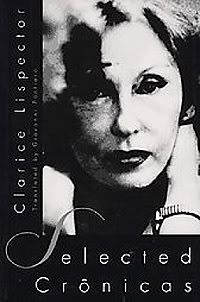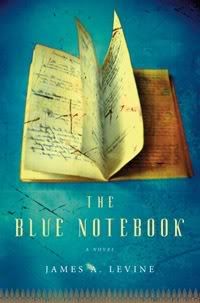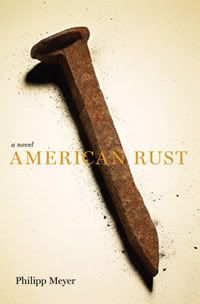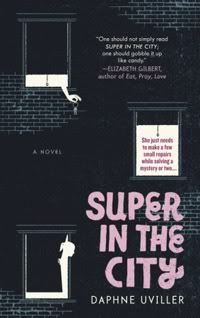 Title: Selected Crônicas
Title: Selected Crônicas
Author: Clarice Lispector, translated by Giovanni Pontiero
Publication Date: 1984
I hadn't heard of Clarice Lispector until a few weeks ago, when I read that the revered Brazilian writer was the subject of a new biography. Her books can be difficult to find in the US, and since Selected Crônicas was the only one in my library system, it became my introduction to Lispector's work. Although it contained insightful, philosophical writing, I think I might have preferred one of her novels.
In the preface, translator Giovanni Pontiero explains that the crônica is "a genre peculiar to Brazil which allows poets and writers to address a wider readership on a vast range of topics and themes." These writings are usually informal and brief. Lispector wrote her crônicas for a Brazilian newspaper between 1967 and 1973 and included ruminations on varied subjects such as her childhood, family, travels, and occupation as a writer. Lispector is provoked and inspired by the most mundane events--a stranger who smiles at her, getting her hair cut, having a conversation with a taxi driver, reminiscing about her children. Autobiographical and deeply introspective, Lispector's writings also frequently examine the themes of identity and mortality.
The crônicas can be interesting, but given their short nature, I often wondered what else Lispector had to say on her many subjects. The longest of these works is only a few pages in length, with the majority lasting less than a page. I was occasionally frustrated as it seemed that Lispector could have gone on much longer, exploring her vast and complicated themes. I look forward to reading one of her novels.
 Title: The Stettheimer Dollhouse
Title: The Stettheimer Dollhouse
Author: Sheila W. Clark
Date: 2009
Carrie Stettheimer constructed her dollhouse between 1916 and 1935, decorating the rooms in a then-modern fashion and acquiring miniature artwork and sculptures designed for the dollhouse by prominent artists. The book outlines the history of the dollhouse and each room is described and photographed in detail. At the end of the book, there are close-ups of the art created for the house along with information about the works and their artists.
I saw the house in person at he Museum of the City of New York, and I now wish that I had this book before. I'm a fan of miniatures and there's no denying that the house is exceptional, but the background about the art, Carrie Stettheimer, and the rooms' interior design make me appreciate it even more. I hadn't realized how accurately it modeled the interior design trends of 1920s New York or what an extraordinary miniature art gallery it possessed. My other wish is that the book had been larger, allowing for bigger photographs of the house. Overall, it's a lovingly compiled and informative book about a lovingly created and historically significant dollhouse.
 Title: The Blue Notebook
Title: The Blue Notebook
Author: James A. Levine, MD
Date: 2009
Levine's first novel is told from the perspective of Batuk, a fifteen-year-old prostitute in Mumbai. Unlike most girls in her position, Batuk has learned to read and write, and finds solace and enjoyment in keeping a diary. Throughout the novel, she chronicles memories of the family who gave her away, the brutality she faces from her employers and clients, as well some of the happier moments she shares with her friends, namely Puneet. Puneet is a young male prostitute who receives more clients than his female counterparts, and possibly even crueler treatment.
The story can become graphic as Batuk offers details about her job and the violence she faces from those who exercise their power over her through beatings and rape. The author, James A. Levine, is a medical doctor who was inspired to write the novel after interviewing homeless children in Mumbai, including a prostitute he saw writing in a notebook, as part of his work for the Mayo Clinic. Nevertheless, Batuk seems believable, at least in so far as Levine captures the voice of a young, imaginative and intelligent girl who is suddenly forced into a harsh, adult world. When one of Batuk's clients asks why she writes, she responds, "I like to see my thoughts because otherwise they are invisible." It's a powerful statement, knowing that Batuk's thoughts are irrelevant to most people in her life, and that her journal is her only refuge. There is the sense, however, that Levine hopes to give a voice to the many real children who share Batuk's fate. (And all of his US royalties from the book are donated to the International Center for Missing and Exploited Children.)
 Title: This Song is You
Title: This Song is You
Author: Arthur Philips
Date: 2009
Music has always been an important part of Julian Donahue's life. Carrying an iPod filled with thousands of songs, each with special significance, Julian is aware of the ways a song can capture a listener and become an important player in relationships and experiences unconnected to music itself. Although the middle-aged advertisement director's life hasn't gone as planned, and he is separated from his wife, songs offer some consolation to Julian, who feels that "music lasted longer than anything it inspired." One night in a Brooklyn bar, he hears the performance of Cait O'Dwyer, a young rock singer on the verge of stardom, and becomes infatuated with both the musician and her songs. Julian reaches out to her anonymously in the form of career advice, and the two continue to communicate with enigmatic messages.
Through Julian's own history with music and his unusual relationship with Cait, Phillips explores music's ability reawaken moments and emotions from the past. The characters' longing from a distance adds suspense to the story, but with time, it's clear that Julian desires something greater than Cait herself. Of course, with music playing such an important role in the novel, her songs are an impetus for Julian to sort out his life, and ultimately, the story is a testament to the ways music captures the past and affect the future. (Edited because I started to ramble. I'll sort it out and add more to the review later, so it's more review and less summary.)
 Title: American Rust
Title: American Rust
Author: Philipp Meyer
Date: 2009
Philipp Meyer's debut novel depicts life in Buell, Pennsylvania, a rapidly declining steel town, from the perspective of six characters. Once a thriving town, the closure of the steel mills in Buell resulted in heavy unemployment and the inability to create new jobs. The story centers around 19-year-old Isaac, who wants to escape the town and his troubled family to attend college in California, and his friend Poe, once the high school's star quarterback, still living in his mother's trailer several years after graduation. Isaac's plan takes an unexpected turn, however, and leaves Poe in a life-altering position.
Although the story is told entirely in third person, chapters are divided among the six characters, and the voice used in each chapter usually changes accordingly. In addition to Isaac and Poe, the novel follows Lee, Isaac's sister who escaped Buell to attend an Ivy League university, Henry, Isaac and Lee's disabled and widowed father, Grace, Poe's disillusioned mother who works in order to support both herself and her son, and Harris, a cop of dubious ethics and friend to Grace. Telling the story from these various perspectives seems to lend itself to repetition (e.g. If a chapter about Grace explains her relationship with Harris, does it need to be explained again in a chapter about Harris?). While this can be frustrating, at times it adds to the sense that the characters are trapped in the same town with the same people with little change throughout the years.
The change in voice is most successful in the chapters about Isaac and Poe, who are also the most developed characters. Isaac's expectations about his runaway plot tend to be grandiose, and his personality ranges from quirky to troubling as he often ignores the grave consequences of his actions despite his intelligence. Poe's frustration and bitterness are laced throughout his chapters along with a disheartening resignation to the path his life has taken. At one point, Meyer writes of Poe, "I am giving up my life, he said aloud. But still the words brought nothing to his mind, no description, only a very faint feeling, he might have been saying I would like a glass of milk." While Poe's resignation is most extreme, this sense of futility, that any attempt to hope or escape will be thwarted, is typical of all the characters. Meyer captures the stagnation of life in a dying town, and it's interesting to observe how his characters make choices and justify their actions when faced with severely limited options
 Title: Super in the City
Title: Super in the City
Author: Daphne Uviller
Date: 2009
In the wake of the former superintendant's arrest, Zephyr Zuckerman finds herself in charge of the Greenwhich Village building she has occupied her entire life. At 27, Zephyr still hasn't decided what she wants to do when she grows up, but she has no difficulty concocting ambitious, albeit far fetched, plans for herself. Zephyr's new job as super is her first foray into true responsibility and sets her life into motion, even if it isn't as exciting as she imagined.
I was expecting the book to be more of a more mystery, but with the exception of a sub-plot involving an exotic French neighbor, the story is largely about Zephyr (and her potential boyfriend and her girlfriends and their potential boyfriends). I don't usually enjoy novels in the "chick lit" genre, but I liked this book as a bit of escapist fun. Zephyr and her friends were witty, self-deprecating, and had lives that were comprised of more than their dates and fashion choices.
 Title: Selected Crônicas
Title: Selected Crônicas






Author: Rodes Fishburne
Date: 2008
Already in his mid-twenties, Slater Brown worries that his dream of becoming the greatest writer of all time is in jeopardy, so he arrives in San Francisco, where he plans to wait for some fortuitous chain of events that will make his literary genius known to the world. In the meantime, the young literary hopeful and modern-day dandy embarks on journalism career, acquiring his much-talked-about scoops by ethically questionable means, becomes a San Francisco celebrity, and falls in love with a beautiful, young chess master. (Note that the novel unfolds in a surreal, dreamlike San Francisco where psychic abilities may be real, an inventor named Milo Magnet can create weather events, and a mayor in crisis can consume enough food to render him unable to fit through his office doorway.) Although Slater is phenomenally successful, he begins to doubt whether he desires the success he has obtained. When he realizes that fate doesn't follow the plans he has made for himself, Slater is forced to reassess his life.
While the quirkiness of pseudo-San Francisco and its fictional denizens is amusing, it feels a bit overdone as the novel progresses, and the book starts to drag somewhat once Slater falls in love. I also would have liked to have read more about the sub-plot involving inventor Milo Magnet, since he seemed at least as interesting as Slater Brown. But if, like Slater, you've been enamored with a place, your plans, and your vision of yourself . . . only to realize that your ideas about all of the above lacked any basis in reality, you'll probably find something to appreciate in this book